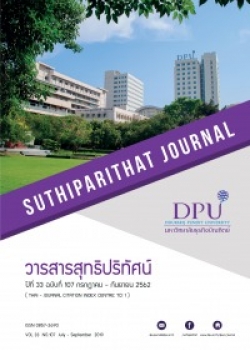การสร้างแบบวัดการคิดเชิงบริหารของนักเรียนวัยรุ่นระดับมัธยมศึกษาตอนปลาย
คำสำคัญ:
การวิเคราะห์องค์ประกอบเชิงยืนยัน, การคิดเชิงบริหาร, เกณฑ์ปกติ, นักเรียนวัยรุ่นบทคัดย่อ
การวิจัยนี้มีวัตถุประสงค์เพื่อสร้างและตรวจสอบคุณภาพของแบบวัดการคิดเชิงบริหาร รวมทั้งสร้างเกณฑ์ปกติของการคิดเชิงบริหารของนักเรียนวัยรุ่นระดับมัธยมศึกษาตอนปลาย กลุ่มตัวอย่างคือนักเรียนชั้นมัธยมศึกษาปี ที่ 4-6 ในโรงเรียนสังกัดสำนักงานคณะกรรมการการศึกษาขั้นพื้นฐานทั้ง 6 ภูมิภาค ซึ่งได้จากการสุ่มแบบหลายขั้นตอน การวิจัยนี้จำแนกเป็น 2 ระยะ ในระยะแรกกลุ่มตัวอย่างสำหรับนำเครื่องมือไปทดลองใช้ จำนวน 209 คน และการวิเคราะห์องค์ประกอบเชิงยืนยันของโมเดลการวัดการคิดเชิงบริหารของนักเรียนวัยรุ่น จำนวน 800 คน การวิจัยระยะ ที่ 2 กลุ่มตัวอย่างมีจำนวน 4,414 คน เครื่องมือที่ใช้ในการวิจัย ได้แก่ แบบสัมภาษณ์กึ่งโครงสร้างและแบบวัดการคิดเชิงบริหารของนักเรียนวัยรุ่นมัธยมศึกษาตอนปลาย สถิติที่ใช้ในการวิจัย ได้แก่ การหาค่าความเที่ยงตรง ค่าอำนาจ จำแนกค่าความเชื่อมั่น การวิเคราะห์องค์ประกอบเชิงยืนยันและการหาเกณฑ์ปกติ (Normalized T-Score) ซึ่งผลการ วิจัยพบว่า 1) นิยามการคิดเชิงบริหารของนักเรียนวัยรุ่นระดับมัธยมศึกษาตอนปลายประกอบด้วย 3 องค์ประกอบหลัก ได้แก่ การกำกับด้านการรู้คิด การกำกับด้านอารมณ์และการกำกับด้านพฤติกรรม 2) แบบวัดการคิดเชิงบริหารของนักเรียนวัยรุ่นมีลักษณะเป็นมาตราส่วนประมาณค่า 5 ระดับ จำนวน 40 ข้อ มีค่าอำนาจจำแนกระหว่าง 0.233-0.553 ค่าความเชื่อมั่นเท่ากับ 0.866 และผลการวิเคราะห์องค์ประกอบเชิงยืนยัน พบว่า โมเดลการวัดการคิดเชิงบริหารของนักเรียนวัยรุ่นมีความสอดคล้องกลมกลืนกับข้อมูลเชิงประจักษ์ (χ2 = 9.49, df = 9, p = 0.393, GFI = 1.00, AGFI = 0.99, CFI = 1.00, SRMR = 0.011, RMSEA = 0.008) และ 3) คะแนนมาตรฐานการคิดเชิงบริหารของนักเรียนวัยรุ่นมีค่าสูงสุดเท่ากับ 86 และมีค่าต่ำสุดเท่ากับ 14 และคะแนนมาตรฐานการคิดเชิงบริหารของนักเรียนวัยรุ่นโดยภาพรวมและรายองค์ประกอบส่วนใหญ่อยู่ในระดับปานกลางและระดับต่ำถึงต่ำมาก
เอกสารอ้างอิง
นวลจันทร์ จุฑาภักดีกุล. (2558). Development of executive functions in early childhood. รวมบทความวิชาการจากการสัมมนา Brain and Mind Forum ครั้งที่ 2: Cognitive Neuroscience. กรุงเทพฯ: สหมิตรพริ้นท์ติ้งแอนด์พลับลิชชิ่ง.
นวลจันทร์ จุฑาภักดีกุล. (2558). Executive functions กับความพร้อมทางการเรียนในเด็กปฐมวัย. เอกสารประกอบงานมหกรรมทางการศึกษาเพื่อพัฒนาวิชาชีพครู ครั้งที่ 8 EDUCA 2015 วันที่ 14 ตุลาคม พ.ศ. 2558.
นวลจันทร์ จุฑาภักดีกุล. (2558). การพัฒนาทักษะสมอง Executive Functions–EF (ทักษะสมองเพื่อชีวิตที่สำเร็จ) ในเด็กปฐมวัย. กรุงเทพฯ: สถาบันอาร์แอลจี.
นวลจันทร์ จุฑาภักดีกุล, ปนัดดา ธนเศรษฐกร, อรพินท์ เลิศอวัสดาตระกูล, และนุชนาฏ รักษี. (2560). ประเมินผลการเรียนรู้ในโครงการสร้างพลเมืองที่มีความรับผิดชอบต่อสังคม (Active Citizen) ต่อทักษะการคิดเชิงบริหารและการกำกับตนเองไปสู่เป้าหมายวัยรุ่น. สืบค้นเมื่อ 12 กันยายน 2560 จาก https://thepotential.org/2017/12/29/ef-symposium-2017-02/.
บุญเลี้ยง ทุมทอง. (2555). ระเบียบวิธีวิจัยทางหลักสูตรและการสอน. กรุงเทพฯ: โรงพิมพ์แหลมทอง.
พูลพงศ์ สุขสว่าง. (2556). โมเดลสมการโครงสร้าง. กรุงเทพฯ: วัฒนาพาณิช.
ไพศาล วรคำ. (2554). วิจัยทางการศึกษา. มหาสารคาม: มหาวิทยาลัยมหาสารคาม.
ยุทธ ไกยวรรณ์. (2557). การวิเคราะห์สถิติหลายตัวแปรสำหรับการวิจัย (พิมพ์ครั้งที่ 2). กรุงเทพฯ: จุฬาลงกรณ์มหาวิทยาลัย.
วิไลลักษณ์ พงษ์โสภา. (2555). สุขวิทยาจิต. กรุงเทพฯ: จุฬาลงกรณ์มหาวิทยาลัย.
ศิริชัย กาญจนวาสี. (2556). ทฤษฎีการทดสอบแบบดั้งเดิม = Classical test theory (พิมพ์ครั้งที่ 7). กรุงเทพฯ: จุฬาลงกรณ์มหาวิทยาลัย.
ศิริชัย กาญจนวาสี, ทวีวัฒน์ ปิตยานนท์, และดิเรก ศรีสุโข. (2544). การเลือกใช้สถิติที่เหมาะสมสำหรับการวิจัย (พิมพ์ครั้งที่ 3). กรุงเทพฯ: บุญศิริการพิมพ์.
ศรีเรือน แก้วกังวาล. (2553). จิตวิทยาพัฒนาการชีวิตทุกช่วงวัย (พิมพ์ครั้งที่ 9). กรุงเทพฯ: มหาวิทยาลัยธรรมศาสตร์.
สุวิมล ติรกานันท์. (2551). การสร้างเครื่องมือวัดตัวแปรในการวิจัยทางสังคมศาสตร์: แนวทางสู่การปฏบัติ. กรุงเทพฯ: ธรรกมลการพิมพ์.
สมนึก ภัททิยธนี. (2546). การวัดผลการศึกษา (พิมพ์ครั้งที่ 4). กาฬสินธุ์: ประสานการพิมพ์.
Anderson, P. (2002). Assessment and development of executive function (EF) during childhood. Child Neuropsychology, 8(2), 71-82.
Alloway, T. P., & Alloway, R. G. (2010). Investigating the predictive roles of working memory and IQ in academic attainment. Journal of Experimental Child Psychology, 106, 20-29.
Bailey, C. E. (2007). Cognitive accuracy and intelligent executive function in the brain and in business. Annuals of the New York Academy of Sciences, 1118, 122–141.
Dawson, P., & Guare, R. (2009). Smart but scattered: The revolutionary executive skills approach to helping kids reach their potential. New York: Guilford Press.
Dawson, P., & Guare, R. (2012). Coaching students with executive skills deficits. New York: The Guilford Press.
Diamond, A. (2012). Activities and programs that improve children’s executive functions. Current Directions in Psychological Science, 21(5), 335-341.
Diamond, A. (2013). Executive functions. Annu Rev Psychol, 64, 135-168.
Duckworth, A. L., & Seligman, M. E. P. (2005). Self-discipline outdoes IQ in predicting academic performance of adolescents. Psychological Science, 16, 939-944.
Eakin, L., Minde, K., Hechtman, L., Ochs, E., Krane, E., Bouffard, R., & Looper, K. (2004). The marital and family functioning of adults with ADHD and their spouses. Journal of Attention Disorders, 8(1), 1-10.
Fournet, N. et al. (2015). Multigroup confirmatory factor analysis and structural invariance with age of the behavior rating inventory of executive function (BRIEF)-french Version. Child Neuropsychology, 21(3), 379-398.
Gioia, G. A., Isquith, P. K., Guy, St. C., & Kenworthy, L. (2000). Behavior rating inventory of executive function (BRIEF). Odessa, FL: Psychological Assessment Resources.
Gioia, G. A., Isquith, P. K., Retzlaff, P. D., & Espy, K. A. (2002). Confirmatory factor analysis of the behavior rating inventory of executive function (BRIEF) in a clinical sample. Child Neuropsychology, 8(4), 249-257.
Goldstein, S., Naglieri, J., Princiotta, D., & Otero, T. (2014). Introduction: A history of executive functioning as a theoretical and clinical construct. In handbook of executive function. New York: Springer Science.
Grafman, J., & Litvan, I. (1999). Importance of deficits in executive functions. Lancet, 354(9194), 1921-1923.
Hair, J. F., Black, W. C., Babin, B. J., & Anderson, R. E. (2010). Multivariate data analysis (7th ed.).Upper Saddle River, New Jersey: Prentice–Hall.
Kaufman, C. (2010). Executive function in the classroom: Practical strategies for improving performance and enhancing skills for all students. Maryland: Paul H. Brookes Publishing.
Mcclelland, M. M., Acock, A. C., & Morrison, F. J. (2006). The impact of kindergarten learning related skills on academic trajectories at the end of elementary school. Early Childhood Research Quarterly, 21(4), 471-490.
Miller, E. K., & Cohen, J. D. (2001). An integrative theory of prefrontal cortex function. Annual Review of Neuroscience, 24, 167-202.
Mladen, P., & Hana, V. (2018). The relationship between executive functions and physical activity in children with an intellectual disability. Journal of Physical Education and Sport, 18(2), 844-852.
Parkin, A. J. (1998). The central executive does not exist. Journal of the International Neuropsychological Society, 4(5), 518-522.
Prosen, S., & Vitulic, H. S. (2014). Executive function in different groups of university students. Review of Psychology, 21(2), 137-143.
Vuontela, V., Carlson, S., Troberg, A. M., Fontel, T., Simola, P., Saarinen, S., & Aronen, E. T. (2013). Working memory, attention, inhibition and their relation to adaptive functioning and behavioural/emotional symptoms in school-aged children. Child Psychiatry Human Development, 44, 105-122.
ดาวน์โหลด
เผยแพร่แล้ว
รูปแบบการอ้างอิง
ฉบับ
ประเภทบทความ
สัญญาอนุญาต
เนื้อหาและข้อมูลในบทความที่ลงตีพิมพ์ในวารสารสุทธิปริทัศน์ ถือเป็นข้อคิดเห็นและความรับผิดชอบของผู้เขียนบทความโดยตรงซึ่งกองบรรณาธิการวารสาร ไม่จำเป็นต้องเห็นด้วย หรือร่วมรับผิดชอบใด ๆ
บทความ ข้อมูล เนื้อหา รูปภาพ ฯลฯ ที่ได้รับการตีพิมพ์ในวารสารสุทธิปริทัศน์ ถือเป็นลิขสิทธิ์ของวารสารสุทธิปริทัศน์หากบุคคลหรือหน่วยงานใดต้องการนำทั้งหมดหรือส่วนหนึ่งส่วนใดไปเผยแพร่ต่อหรือเพื่อกระทำการใด ๆ จะต้องได้รับอนุญาตเป็นลายลักษณ์อักษรจากวารสารสุทธิปริทัศน์ก่อนเท่านั้น







